|
||||||||
|
|
|
2020-08-03 ArtNo.46861
◆Review:The baptism of the Holy Spirit (Aramaic roots VII)
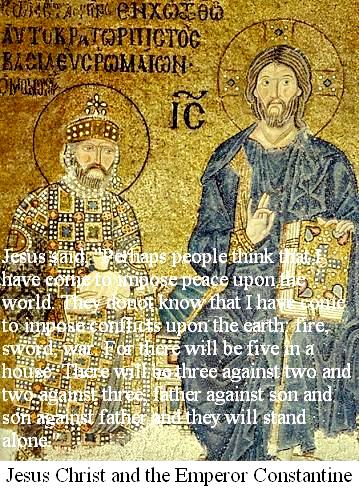 Jesus said, "Perhaps people think that I have come to impose peace upon the world. They donot know that I have come to impose conflicts upon the earth: fire, sword, war. For there will be five in a house: There will be three against two and two against three, father against son and son against father and they will stand alone." (Thomas 16) According to Mr. Sasagu Arai, author of the Japanese version of The Gospel of Thomas, the verse sixteen of the Gospel of Thomas is almost in line with parallel articles in the Gospel of Matthew (10: 34-36) and the Gospel of Luke (12: 51-53), except for the last phrase. But the verse sixteen of the Gospel of Thomas does not describe the split between women (daughter and mother, wife and mother-in-law). Because the whole theme of the Gospel of Thomas is the independence of child (son = male) from father on earth (Thomas 23/49), and a woman must become a man to enter heaven. And the last sentence of the verse is certainly an addition by Thomas. Q source describes the split that takes place in a family by believing in Jesus and following Him, while, in the Gospel of Thomas, beyond that, the split, as the process in which "a child" becomes "One" especially from "father" together with Jesus, is emphasized. As confirming in the verse 4, becoming 'One' or 'Single one,' for Thomas, means 'recovering the original integration in himself.' ○'Three-One mysterious substance' and the statue of Maitreya 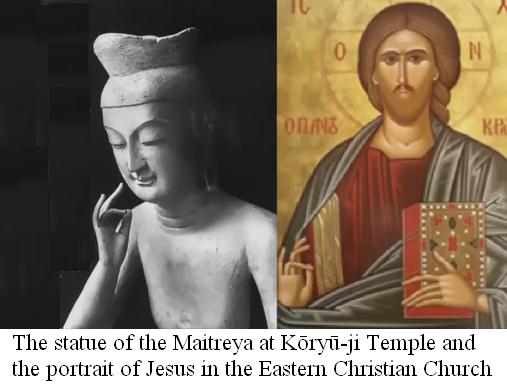 By the way, in the sphere of influence of the Eastern Church, there are many portraits of Jesus in a pose in which a ring is made with the ring finger and the thumb of his right hand, and the remaining three fingers are raised. This kind of portrait cannot be found in the sphere of influence of the Western Christian Church. These portraits are probably icons that symbolizes the doctrine of the Eastern Church's 'Three-One mysterious substance (三一妙身).' The words, "For there will be five in a house: There will be three against two and two against three, father against son and son against father," in the verse sixteen of 'The Gospel of Thomas' may also have something to do with these icons. Regarding 'Three-One mysterious substance,' at the beginning of its inscription, Daqin Jingjiao Popular Chinese Monument (大秦景教流行中国碑: Nestorian Stele) says, "Lo the unchangeably true and invisible, who existed through all eternity without origin; the far-seeing perfect intelligence, whose mysterious existence is everlasting; operating on primordial substance he created the universe, being more excellent than all holy intelligences, inasmuch as he is the source of all that is honorable. This is our eternal true lord Allah (阿羅訶歟), Three-One mysterious substance. He appointed the cross as the means for determining the four cardinal points, he moved the original spirit, and produced the two principles of nature;" and describes 'Three-One mysterious substance (三一妙身)' as the substance of Allah (Yahweh). In other words, the guardian deity of Jingjiaotu (景教徒: Believers of Luminous Religion) was Allah, and the Muslims are also considered to have followed it. Then what is 'three'? In light of the 'Trinity' doctrine in the Western Church, the general interpretation is to say "God" as Father, "Jesus" as the Son, and "the Holy Spirit." While, Laozi (老子), a Chinese thinker in Spring and Autumn period (BC770-BC500), wrote in his book, 'Tao Te Ching (道徳経)' that "everything consists of 'yin (陰)' and 'yang (陽),' but 'the way of humanity' is neither 'yin' nor 'yang.' It is 'qi (炁),' and 'qi' is the chaos, which is not yet divided into 'yin' and 'yang' like the primordial universe." It is reminiscent of 'recovering the original integration in oneself' taught by 'Gospel of Thomas' and the doctrine of 'Three-One mysterious substance' described on the Nestoriam Stele. By the way, the pronunciations of "炁" and "気" in Chinese are the same, and they have almost the same meanings, but the former is used as a philosophical term. In English, they correspond to 'Holy Spirit' and 'spirit.' Regarding 'One', 'Daodejing' says, "All things are produced because they have "One" and kings have sovereignty because they have "One". "One" gives them their essence.(Ch 39)" And it also says, "'The way' produces One. One produces Two. Two produces Three. Three produces all things. All things are carrying 'yin (陰)' and holding 'yang (陽).' These two are harmonized by the mediating breath (沖気). (Ch 42)" Wang Bi(王弼 226-249), a great thinker of the Xuanxue (玄学: Dark Learning, Mysterious Learning or Profound Learning) during the Wei, Jin, and Southern and Northern Dynasties (魏晋南北朝) era, said, "'One (一)' is the beginning of the number, and this is the extreme of things, so called 'Miaoyou (妙有mysterious-being),' he who wants to be called 'You (有being),' doesn't see its shape, so it is not being, therefore, it's called 'miao (妙mysterious).' Though someone wants to call it 'Wu (無nothing),' but things are born because of this, so it is not 'Wu,' that is why it is 'You (有).' This is 'You (有)' existed in 'Wu (無),' thus it is called 'Miaoyou (妙有mysterious existence).' As it means that 'Miaoyou (妙有) is 'One (一)' that is the beginning of the number and is the extreme of things, and it is neither 'You (有)' nor 'Wu (無)' but exists both in 'You (有)' and 'Wu (無).' By the way, Xuanxue (玄学) is a scholarship that interpreted Yijing (易経), Laozi (荘子) and Zuangzi (荘子), which were called the 'sanxuan (三玄three mysteries),' and was popular during the Wei, Jin, and Southern and Northern Dynasties era of China. Sengzhao (僧肇), who was known as one of the four Sages among Kumaarajiiva (鳩摩羅什350-409)'s three thousand students and the best 'emptiness' theoretician, said in his book 'Zhaolun Niepanwuminglun (肇論:涅槃無名論),' Chapter 4, "The true way is in the complete enlightenment, and the complete enlightenment is in the bare truth. If you have got the bare truth, you would see both presence and absence. If you see both presence and absence, there is no difference between the other and you. Therefore heaven, earth, and I have the same root and myriad things and I are one body." The doctrine of 'Three-One mysterious substance' reflects the experiences that Thomas gained in his trip of preaching India and China, and the influences of Buddhism and Taoism are strongly felt. Moreover, this kind of influence is bidirectional, and it is considered that the Mahayana Buddhist schools that were prosperous in India at that time and the philosophies of Tiantai (天台) and Hua-yan (華厳) that emerged in China after that were also greatly stimulated by the Gnostic Christianity taught by Thomas. It can be said that the Buddha's three-body theory (仏陀三身説), that is, 'Dharmakaya (法身) which symbolizes the absolute truth or Li (理: universality), Nirmanakaya (応身) which symbolizes actual Buddha appeared in this historical world under spatial and temporal limitations or Shi (事: particularity) and Sambhogakaya (報身) which symbolizes interfusion between Li (理: universality) and Shi (事: particularity)' is a typical example. It may be mentioned that just around that time Fazang (法蔵643–712). who became a priest in obedience to the Imperial order and succeeded to the third patriarch of the Huayan school of Buddhism (華厳宗) and lectured to Empress Wu ZeTian (則天武后) and other high ranked officials on Huayan philosophy (華厳哲学) in the court, was from Sogdiana, one of Aramaic countries in western region of China. The statue of Maitreya Bodhisattva (弥勒菩薩像), which is said to have been given to Japan by Silla in 603 AD, in Koryuji Temple (広隆寺), makes that shape of fingers of its right hand. At that time, Koguryo, Silla, and Baekje stood on the Korean Peninsula, each striving to strengthen their relationship with Japan. Though the tribe in Kitakyushu, led by Emperor Jimmu (神武天皇)'s older brother Inainomikoto (稲飯命), seems to have had a blood relation with Kingdom of Silla (新羅), Yamato Kingdom (大和王権) had taken a diplomatic stance supporting Baekje (百済) since the Emperor Ojin (応神天皇)'s reign. When Baekje, which had invaded by Silla, asked Japan to rescue. Emperor Keitai (継体天皇) tried to send an expeditionary force to Korean Peninsula, but Iwai (磐井), a clan of Tsukushi in Kitakyushu, revolted joining hands with Silla. Even in the days of Prince Shotoku (聖徳太子), Soga (蘇我) and other clans linked Baekje were preparing to dispatch troops to Korea. Therefore, Silla sent to Japan the statue of Maitreya Bodhisattva, which symbolizes the doctrine of 'Three-One mysterious substance,' perhaps in order to restore old relations with the Yamato Imperial Court returning to the Emperor Jimmu's era. At that time in Silla there were several groups of knights called Hwa-rang (花郎) composed of children of the noble families who worshiped Mireuk-posal(弥勒菩薩) and played an active role in the Kingdom. The Maitreya Faith of Silla seems to have incorporated the doctrine of 'Three-One mysterious substance' of the primitive Christianity which had been believed by Yamato Imperial family and Hata clan (秦氏). ○Hebrew genes in Japanese 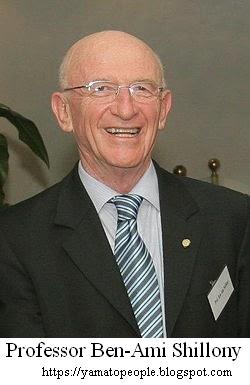 Mr. Ben-Ami Shillony, an emeritus professor at the Hebrew University of Jerusalem, who is also the Honorary President of the Israeli Association for Japanese Studies, points out that there are many vocabularies similar pronunciation and meaning with Hebrew in Japanese words. The following examples are just a few and say that counting down is not less than 500. At first glance it covers various areas of everyday life. And this seems to be the proof that a large number of Jews continued to visit the Japanese archipelago for a long time probably since the ancient times, dating back to the Jomon period, and had a mass-level exchange with the indigenous people of Japan but not only the imperial family. Wangchong(王充), a Chinese thinker in Later Han (後漢) period, wrote "During Zhou (周) King Cheng (成王: BC1042-BC1021)'s era, the country was well ruled and peaceful. The Vietnamese (越裳) donated white pheasants and the people of Wa (倭: General name of the Japanese archipelago in ancient China) contributed herbs (鬯草). However, eating the white pheasants and taking the herbs did not prevent evil matters." in his book 'Lun heng(論衡: Discourses in the Balance).' Since it was impossible for the Jomon people (縄文人) to have delivered medicinal herbs all the way to the capital of Zhou (周) Haojing (鎬京), which was located west of Xi'an City (西安), Shaanxi Province (陝西省), Aramaic-speaking herders were already based in the Japanese archipelago around that time and may have sold the products such as herbs in China. If so, the connection between Japan and Judah could be traced back to the days when Joshua, the successor of Moses, seized the West Bank of the Jordan river, but the kingdom of Israel had not yet been born. If this is the case, it can be nodded that "But the eastern barbarians (東夷) were naturally obedient and different from the other three sides. Therefore, when Confucius (孔子) lamented that the humanity had been gone, he said, 'If I could float on the sea, I would like to live in the nine barbaric lands.' There was a reason. It has been said that there had been hundreds of Wa nations across the sea of Le lang (楽浪: Near current Pyongyang) and their envoys had come to see our emperors." which is written in 'Book of the Later Han; Geographica the land of Yan (漢書:地理志燕地条)' and "There are 24 countries of Dong-ti people (東鯷人) in the waters beyond Huiji (会稽: Near Shaoxing City of Zhejiang Province浙江省紹興市). There are also Yizhou (夷州) and Chanzhou (澶州). There is a following legend; 'Qin Shi Huang (秦始皇), the first emperor of unified China, ordered a sorcerer called XuFu (徐福) to go to Penglai Country (蓬莱国) and obtain the medicine for perpetual youth and longevity. XuFu took thousands of boys and girls and crossed the sea, but failed to obtain the medicine. XuFu was afraid of being executed, stayed in the country and did not return.' For this reason, the number of people in the country has grown to several tens of thousands over several generations, and occasionally come to Huiji (会稽) and trade. Some people living in Dongye district (東冶県) of Huiji (会稽) some time drift to Chanzhou (澶州) but they cannot travel back and forth because it is too remote place." which is written in 'Book of the Later Han; Geographica the land of Wu (漢書:地理志呉地条).' In other words, these Aramaic-speaking nomads not only led the Jewish refugees of Israel, which had been divided and finally destroyed, but also Chinese, Mongolian and Korean refugees to the Japanese archipelago one after another and seem to have promoted the transition from the Jomon period to the Yayoi period. 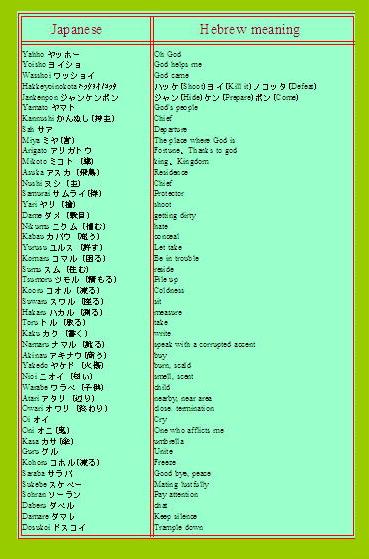 ○Ephraim and Manasseh mediate Korean roots of Imperial framily 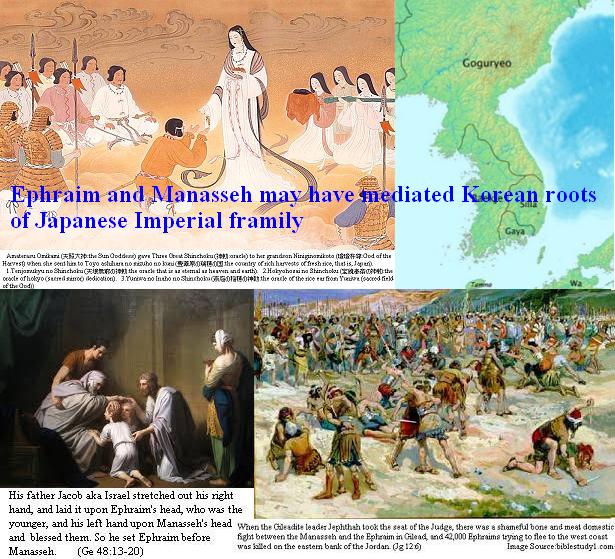 While the descriptions in the Nihon Shoki (日本書紀) and Kojiki (古事記) imply that the Japanese imperial family has blood relations with both Silla (新羅) and Baekje (百済) and it appears that the Ephraim and Manasseh tribes of the ten lost tribes of Israel seem to have acted as mediators of them. Because when Nigihayahinomikoto (饒速日尊) descended in Kinki region (畿地方) first, he called his country Yamato kingdom (大和王国) based on the Aramaic word 'Yehoamato', which means 'Yahweh's people' in order to show themselves as the tribe of Tenson (天孫族Imperial ancestors descended from Heaven), residents of the Japanese archipelago including Jomon people (縄文人) began to call themselves Yamato, and it became the national title of the Yamataikoku (邪馬台国) that was born after that. When the General of the Eastern expedition of Kitakyushu based Korean Peninsula-linked clan (Iwai磐井?) vanquished the Kinki region (近畿地方), he inherited the name of the Yamato kingdom and called himself Kamu-yamato-iware-hiko no Mikoto (神日本磐余彦尊), which is derived from the Hebrew-Aramaic words 'Kam Yamato Ephraim Peko Shmelon Makto' and can be interpreted as 'The king of Samaria, the noble founder of the Ephraim tribe of Yahweh.' These suggest that Nigihayahinomikoto established the Yamato kingdom with the cooperation of the Jewish tribe Ephraim, and Emperor Jimmu (神武天皇) also inherited that tradition. On the other hand, it seems that the tribe in Kitakyushu, led by Emperor Jimmu (神武天皇)'s older brother Inainomikoto (稲飯命), later founded Silla (新羅) on the Korean Peninsula. However, both Yamataikoku (邪馬台国) and Yamato Kingdom (大和王権) often dispatched troops to Silla (新羅), taking a diplomatic stance supporting Baekje (百済). In the Emperor Ojin 's reign, the Emperor sent troops to Korean Peninsula twice to realize the arrival of King of Yuzuki (弓月君), who is said to have been the third generation grandson of Qin Shi Huang (秦始皇帝BC259-BC210) and also the ancestor of Hata clan (秦氏) and to have led the people of 120 prefectures and have requested naturalization as Yamato citizens but have been stuck in Kala (加羅) after being disturbed by Silla (新羅). According to the Israeli research agency Amishav, Hata clan seems to have been the descendants of the tribe Manasseh. If the description in "Honchokouinshounroku (本朝皇胤紹運録)" is correct, the current royal family, which belongs to Emperor Keitai's direct line, is likely to be the descendants of the Manasseh tribe. ○A thread of fate binding between St. Thomas' Mission to Beijing and Wa-koku (倭国) 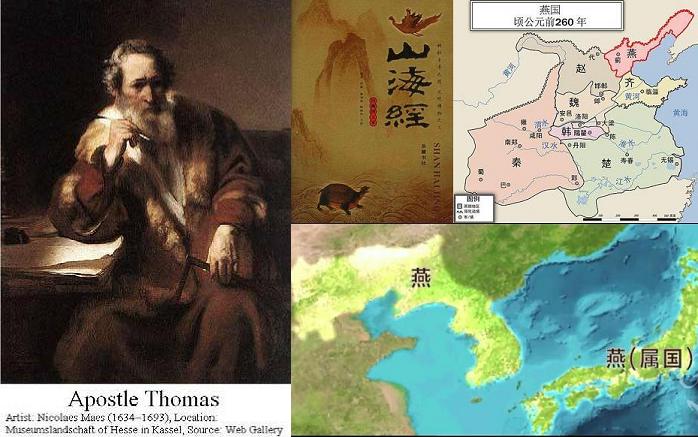 According to Protestant Bible commentator Mr. Arimasa Kubo, who was the first pastor of the Ikebukuro-Nishi Church, The United Church of Christ in Japan, St. Thomas traveled to Assyria around 35 C.E., two years after Jesus' ascension, and went on a mission to India, and then evangelized to China via Tibet, reached the present Beijing (北京) in 62 C.E., and seems to have established an organized church (congregation), too. By the way, why did Thomas go to the northern frontier town called Ji Xian (薊県), but not Luo Yang (洛陽) or Chang An (長安), capital cities of the later Han (后漢)? Apostles at that time, whether Paul or John, all preached to areas where a Jewish community already existed, and it is probable that there was also a Jewish community in Beijing at that time. Come to think of it, on the monument of 'Reconstruction of the Temple of Purity and Truth (重建清真寺記碑)' discovered in Kaifeng city (開封市) of eastern Henan province (河南省) of China, it is said to be written that the Jews first arrived in the city in 231 BC, when General Ben Wang (王賁) of Qin (秦) reduced Wei (魏)'s capital city, Daliang (大梁: current Kaifeng City), and formed a Jewish community. Almost ten years later, in 226 BC, General Ben Wang reduced Yan (燕)'s royal capital, Jicheng (薊城, now the city of Beijing), and Kingdom of Yan was extinguished in 222 BC. Seen as the mother tribe of Qin (秦), the Qiang (羌) tribe was literally herders that grazed sheep, and was a typical descendants of Manasseh, according to Israeli research agency Amishav, organisation aimed at seeking the Lost Tribes of Israel. Therefore, there seems to have been Jewish mercenary units which took put in various battles directly under General Ben Wang and communities of families of these mercenary units might have formed in the area where the General was to battle. Incidentally, China's oldest geography book, "Shanhaijing (山海経: Mountain and Sea sutra)," written during the Spring and Autumn Warring States period (春秋戦国時代) to the Qin-Han era (秦漢時代), states that "The country of Gai (蓋) lies south of Yan (燕) and north of Wo (倭 = Wa in Japanese), and Wo belongs to Yan." This is the first example of "Wo (倭)" appearing in Chinese books. Apparently, "Wo (倭)" seems to have been regarded as a part of "Yan (燕)" around the time from the Spring and Autumn Warring States period to the Qin-Han era. If so, when St. Thomas visited former Yan (燕)'s royal capital Jicheng (薊城), the Jewish community there might have had a close relationship with Yamato Kingdom (大和国), which Nigihayahinomikoto (饒速日尊) had established under the cooperation of the Jewish tribe Ephraim, and Hata clan (秦氏), which was descendants of the Manasseh tribe and had been naturalized in Yamato in the Emperor Ojin (応神天皇)'s reign. ○Mystery of "The Twelve Tribes" 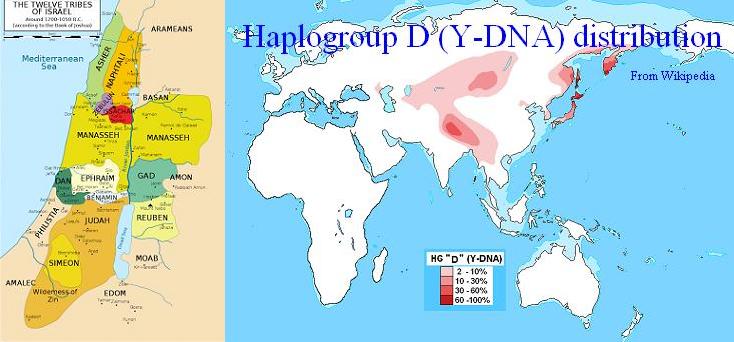 Oddly enough, the Tribe of Levi, of which founder was one of 12 sons of Jacob (also known as Israel), and of which descendants included Moses, is not included in "the Twelve Tribes of Israel." According to The Old Testament, such as The Book of Numbers (1:47-54) and The Book of Joshua (4:1-4), the Levites were not counted among the tribes of Israel because they were given the special tasks to administer the ritual but they were not given their own heritages. "They were not given their own heritages" seems to mean that they had no their territories other than grazing lands. In addition, there seems to have been the tribe of Joseph, of which originator was Joseph, the father of the brothers of Manasseh and Ephraim. (Re 7:8) Thus, the total is 14 tribes. From what I can imagine, "the twelve tribes of Israel" initially may have been made up of the tribes founded by twelve sons of Jacob, that is, the eldest son Reuben, the second son Simeon, the third son Levi, the fourth son Judah, the fifth son Zebulun, the sixth son Issachar, the seventh son Dan, the eighth son Gad, the ninth son Asher, the tenth son Naphtali, the eleventh son Joseph and the twelfth son Benjamin. (Ge 35:23-26) However, it became complicated because "Manasseh" and "Ephraim," probably indigenous nomadic tribes on the eastern bank of the Jordan River were added to the group prior to the total attack on the West Bank of the river. Then perhaps a cover story about Joseph having two sons in Egypt was put in the Old Testament to make ends meet. In this way, when Moses did a census of the Israelites in the wilderness of Sinai, the "Levi" and "Joseph" were probably replaced by the "Manasseh" and the "Ephraim." (Nu 1:1-54) At that time, in contrast to the Manasses who were reluctant to participate in the West Bank conquest, the Ephraim beyond proactively and took the lead of the total attack. The Ephraim also played a leading role in the post-war treatment, and at one time completely excluded the Levi, or Moses' clan, from the distribution of occupied territories, not even a piece of land. From this, it can be seen that a fierce battle for leadership took place within the Nomad Union. In fact, the Ephraim itself may have formed a nomadic coalition to conquer the West Bank. If so, it can be agreeable that among the 14 tribes of Israel, only the lineages of Manasseh and Ephraim have the Y chromosome gene D, which is characteristic of the Tibetans and the Japanese, especially the Jomon people (縄文人). According to recent genetic validation, people having the "Y chromosome gene D" were widely distributed not only in Tibet and the Japanese archipelago but throughout Asia. So both tribes (Manasseh and Ephraim) were nomads who were genetically different from the descendants of the twelve sons of Jacob, including Joseph and their compatriots were widely distributed throughout Central Asia and the Far East. Thus, they seem to have contributed to the penetration of the Jewish community into the eastern world. In any case, they (Manasseh and Ephraim) seem to have played a decisive role not only in the conquest of the West Bank of the Jordan river and the establishment of the Kingdom of Israel by Aramaic-speaking nomads, but also in the foundation of Qin Dynasty, the first Chinese empire, and the Yamato Imperial Court in Japan. ○The origin and history of Isshi Incident Because the Emperor Suiko (推古天皇) died without appointing a successor in 628 C.E., Tamura Miko (田村皇子), the grandsons of Emperor Bintasu (敏達天皇) and Yamashita no Oe Miko(山背大兄皇子), the son of Prince Shotoku (聖徳太子), became promising candidates for the next emperor. Ohomi (大臣:Prime minister) Sogano Emishi (蘇我蝦夷) killed his uncle Sakaibenomarise (境部摩理勢), the son of Soganoiname (蘇我稲目), who advocated Yamashiro Oe no Miko (山背大兄皇子) and let Tamurano Miko (田村皇子) take the throne as Emperor Jomei (舒明天皇). In the year 641 AD, when Emperor Jomei died, the empress's Takara Oujo (宝皇女) took the throne as Emperor Kogyoku (皇極天皇). Soga Iruka (蘇我入鹿) who had become Ohomi (大臣Prime Ministe) on behalf of his father, attacked Yamashironoohenomiko (山背大兄皇子) and made him and all his family members kill themselves and completely destroyed the descendants of Prince Shotoku (聖徳太子) in order to let his cousin Furuhitonooenomiko (古人大兄皇子), who belonged to the lineage of Soga clan, take the throne as next emperore. 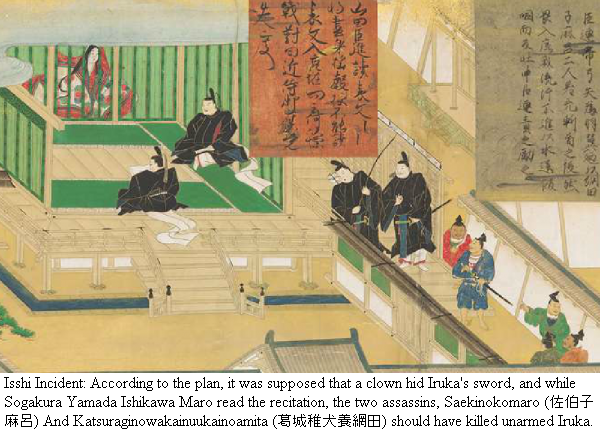 Nakatominokamatari (中臣鎌足: Founder of Fujiwara clan), who was in charge of the rituals of the Yamato Imperial Court, hated Soga clan's dictatorship. He made a plan to overthrow Soga clan together with Kinashinokarunomiko (木梨軽皇子), who was Emperor Kogyoku (皇極天皇)'s younger brother-uterine and would become Emperor Kohtoku (孝徳天皇) later, and Nakanoohenomiko (中大兄皇子), who would become Emperor Tenchi (天智天皇) later. They also brought Soganokurayamadanoishikawamaro (蘇我倉山田石川麻呂) into the group and put the plan into action. According to the plan, it was supposed that a clown hid Iruka's sword, and while Sogakura Yamada Ishikawa Maro read the recitation, the two assassins, Saekinokomaro (佐伯子麻呂) And Katsuraginowakainuukainoamita (葛城稚犬養網田) should have killed unarmed Iruka. However, the assassins were scared and did not come out. So Ishikawamaro started to quiver and even could not read the recitation properly. Nakanooenomiko saw the situation, jumped into the hall himself and delivered a blow to Iruka. Iruka hit the Emperor's throne with his head and complained, "What is my sin? Please judge." Then, Nakanooenomiko said to him "You destroyed the royal families and tried to take over the throne." When Emperor Kogyoku returned into her palace silently, two assassins also joined and killed Iruka. Furuhitonooenomiko (古人大兄皇子) fled back to his private palace. Nakanooenomiko immediately entered Hoko-ji Temple (法興寺) and prepared for battle, and other Princes and clans also followed. The naturalized Ayano Atae (漢直) family gathered at Soga's mansion to try to support Emishi(蝦夷). When they heard that Furuhitonooenomiko had entered the priesthood, all the militants and congregation in Soga's mansion lost their flag and fled. Thus Emishi set fire to his mansion and killed himself. By the way, "Emishi (蝦夷)" is a derogatory name for the indigenous people as hair people(毛人) in the Tohoku region (東北地方), but as a synonym for "courage," other than Soga clan (蘇我氏), Ononoemishi (小野毛人) and Saekinoimaemishi (佐伯今毛人) and Kamonoemishi (鴨蝦夷) are calling themselves "Emishi." When "蝦夷" refers to indigenous people, it is pronounced "Emishi", and when it refers to the Tohoku region, it is pronounced "Ezo." If it is boiled down, the indigenous people of the Tohoku region are considered to have been descendants of the Jomon people (縄文人), but most of the modern people who consider themselves as the Yamato people (大和民族), including the residents of the Yamato Kingdom (大和王国) before the Jinmu Tosei (神武東征: Emperor Jimmu's expedition to the east), Izumo kingdom (出雲王国) and the Yamadaikoku(邪馬台国), are descendants of non-Indigenous people who came after the Yayoi period (弥生時代). ○Hakusonko's defeat and Emperor Tenchi 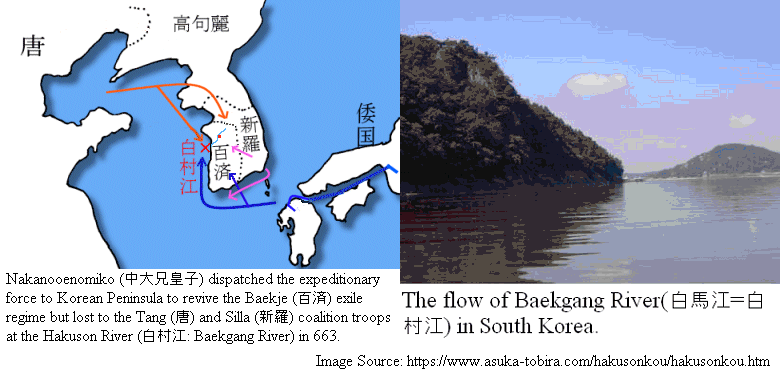 Emperor Kogyoku (皇極天皇) was resigned due to the Isshi Incident (乙巳の変), and Prince Karu (軽王子) took the throne as Emperor Kotoku (孝徳天皇). When Emperor Kotoku (孝徳天皇) died, Emperor Kogyoku (皇極天皇) again took the throne as Emperor Saimei (斉明天皇). During this period, Nakanooenomiko (中大兄皇子), took over the political power as the crown prince, took the lead in reforming the domestic affairs, and conquered the Ezo (蝦夷) and dispatched the expeditionary force to Korean Peninsula. The Ezo (蝦夷) conquest achieved some success, but the dispatching expeditionary force to Korean Peninsula aiming to revive the Baekje (百済) exile regime failed in 663 when they lost to the Tang (唐) and Silla (新羅) coalition troops at the Hakuson River (白村江: Baekgang River). However, immediately after that, he sent an envoy to Tang Dynasty (唐朝) and restored the diplomatic relations with the country. He moved to Omi Otsunomiya (近江大津宮 present Otsu City) on April 17, 667, and finally took the throne as Emperor Tenchi (天智天皇) on February 20, 668. Therefore, after the death of Emperor Saimei (斉明天皇) on August 24, 661, the Emperor's throne remained vacant for more than six years. If Emperor Jinmu (神武天皇)'s elder brother Inainomikoto (稲飯命) was Silla (新羅) Kings' ancestor, then the clan based in Tsukushi (筑紫) of Kitakyushu (北九州) and linked Korean Peninsula would have built Silla Dynasty after merged the Yamato dynasty (大和王朝) founded by Tenson tribe (天孫) Nigihayahinomikoto (饒速日尊). Perhaps his elder brother Inainomikoto continued to control the Tsukushi area of northern Kyushu region as their headquarters, and let his younger brother, Emperor Jinmu, have set up a branch in the Yamato region and have entrusted its management. Thus, the clans based in Kitakyushu may have maintained close ties with the Korean Peninsula, especially with Silla while being semi-independent from the Yamato Imperial Court. In contrast, Yamato Imperial Court showed more intimate attitude to Baekje during such as the migration of the Yuzuki (弓月) king and the conquering of Sankan (三韓) by the Empress Jingu (神功皇后). However, Yamato Imperial Court seems to have forced to make such a dramatic change in diplomatic stance due to the defeat of the battle of the Hakuson River (白村江). After the defeat of Hakuson River (白村江), he strengthened the national defense system by developing Mizuki (水城Sea base), Noroshi (烽火beacon), and Sakimori (防人Border guards), carried out administrative reform through expanding Kanyi (冠位the court ranks) from 19 to 26, created Japan's oldest national family register (戸籍) and laid the foundation for Kochi komin sei (公地公民制: a system of complete state ownership of land and citizens). Also, in 660, he created a water clock called Rokoku (漏刻), and from 671 placed it on a new stand in Palace of Otsunomiya (大津宮) and struck a bell to start a time signal. ○Jinshin War 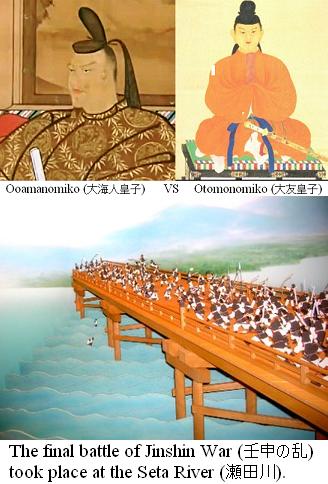 When Nakanooenomiko (中大兄皇子) took the throne as Emperor Tenchi (天智天皇) in 668, he appointed his younger brother, Ooamanomiko (大海人皇子) to the Crown Prince (太子). However, he assigned his son Otomonomiko (大友皇子) as Daijo-daijin (太政大臣Grand Minister) in 671 and at the same time also appointed deputy ministers, such as Sadaiji (左大臣Minister of the left), Udaijin (右大臣Minister of the right) and Gyoshitaifu (御史大夫chief of controlling the officials) to support his son. As a result, Ooamanomiko (大海人皇子) was alienated from the political affairs of Imperial Court. Immediately after that, Emperor Tenchi (天智天皇) got sick and tried to entrust Ooamanomiko (大海人皇子) with the future affairs, but Ooamanomiko retired to enter the priesthood and went to Yoshino (吉野). When Emperor Tenchi (天智天皇) died, Ooamanomiko (大海人皇子) immediately raised an army, won consecutive battles, forced Otomonomiko (大友皇子) to commit suicide and took the throne as Emperor Tenmu (天武天皇) in 673 AD. Both Emperor Tenchi (天智天皇), that is, Nakanooenomiko (中大兄皇子), and Emperor Tenmu (天武天皇), that is, Ooamanomiko (大海人皇子), were children of Emperor Jomei (舒明天皇) and Emperor Kogyoku (皇極天皇)/ Emperor Saimei (斉明天皇). So the two were brothers with same parents. The empress of Emperor Tenmu (天武天皇), Unonosararanohimemiko (鸕野讃良皇女) later became Emperor Jito (持統天皇). The reign of Emperor Tenmu (天武天皇), in conjunction with the era of Emperor Jito (持統天皇), is called Tenmu-Jito-cho (天武持統朝) and it is considered to be an important period when the archetypes of Japanese governing system, religion, history and culture were created. ○The direct rule of the Emperor 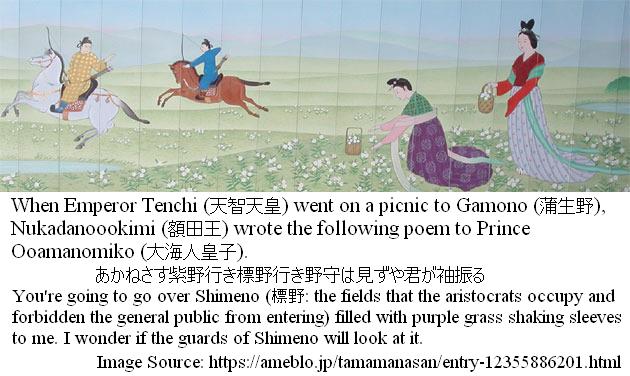 Emperor Tenmu (天武天皇) placed the royal family in key positions and reigned as an autocrat who himself was not meddled even by the royal family. He reorganized Uji-Kabane System (氏姓制度: system of clans and hereditary titles of the Yamato court) through establishment of Yakusa no Kabane (八色の姓: eight hereditary titles) while proceeded with institutional reform toward the introduction of Ritsuryosei (律令制: the political system based on ancient China's laws and ordinance system) and started to build the new capital "Fujiwarakyo (藤原京)" and ordered the compilation of "Nihonshoki (日本書紀)" and "Kojiki (古事記)". These projects were completed after the death of Emperor Tenmu (天武天皇). Ooamanomiko(大海人皇子) married Nukadanoookimi (額田王) and got a doughter Toochinohimemiko (十市皇女). However Nukadanoookimi (額田王) later remarried Nakanooenomiko (中大兄皇子). On the other hand, Ooamanomiko (大海人皇子) married 4 daughters of Nakanooenomiko (中大兄皇子) one after the other. There is a theory that this triangular relationship caused sibling discord. However, the poems exchanged by Ooamanomiko (大海人皇子) and Nukadanookimi (額田王) in the Manyoshu (万葉集: Collection of Ten Thousand poems) show the feeling that they seem to have been enjoying this triangular relationship. -------------- When Emperor Tenchi (天智天皇) went on a picnic to Gamono (蒲生野), Nukadanoookimi (額田王) wrote the following poem to Prince Ooamanomiko (大海人皇子). あかねさす紫野行き標野行き野守は見ずや君が袖振る You're going to go over Shimeno (標野: the fields that the aristocrats occupy and forbidden the general public from entering) filled with purple grass shaking sleeves to me. I wonder if the guards of Shimeno will look at it. Ooamanomiko (大海人皇子) returned the following poem. むらさきのにほへる妹を憎くあらば人妻ゆゑに吾恋ひめやも If I don't like you as beautiful as purple grass, why I miss a being married woman all the time? -------------- Emperor Tenmu (天武天皇) had a deep knowledge of Taoism, maintained Shintoism, protected Buddhism, and created national Buddhism. In the first place, there is a theory that the god Amaterasu Okami (天照大神) was created by Emperor Tenmu (天武天皇). According to it, originally Takamimusuhi (高御産巣日) was the royal god (皇祖神), but Emperor Tenmu (天武天皇) united a sun god, which was enshrined in the Ise region (伊勢地方), with the god enshrined by Imperial family and made Amaterasu Okami (天照大神), then replaced it with Takamimusuhi (高御産巣日). ○Formation and self-destruction of centralized state 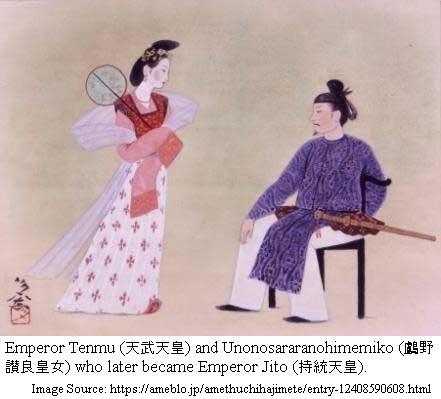 It is say that one who used the name "Tenno (天皇)" in stead of "Ookimi (大王)" that had been used up to that point, and first used the national name "Nihon(日本)," too, was Emperor Tenmu (天武天皇). Until then, the emperors of Yamato Imperial Court (大和朝廷), like Himiko (卑弥呼) and Iyo (壹與) of the Yamadaikoku (邪馬台国), was called Ookimi (大王) as the king of kings or the chief of Clan Union in the Yamato region. However, due to the Taika Reform (大化の改新), the clan system (氏族制度) was dismantled, and after that, both the land and the people were to belong to the possession of the Emperor under the Kochikominsei (公地公民制: a system of complete state ownership of land and citizens). The palace and the shrine were separated and permanent capital cities such as Heijokyo (平城京) and Heiankyo (平安京) were built. In this way, the foundation for the birth of a centralized ancient nation with the Emperor at the top and also holding the standing army was laid. Although the Kochikominsei (公地公民制: civic system) and the standing army system did not last long, the reform played an important role in liberating land and people from the clan's framework and moving to the next feudal society. Emperor Tenmu (天武天皇) issued an order to enact the "Ritsuryo (律令legal codes)" in 681. Then "the Asukakiyomihararei (飛鳥浄御原令)" was enacted in 689, the 3rd year of Emperor Jito (持統天皇) after the death of Emperor Tenmu(天武天皇). However, as its name suggests, it was only "Ryo (令: order)" but "Ritsu (律: law)" was not provided yet. In addition, there were many parts that were not suitable for Japanese national conditions. For this reason, modification work was continued, and the Taiho Ritsuryo (大宝律令) was completed in 701, the first year of Taiho (大宝) in the Nara era (奈良時代). For example, under the law, Kogo (皇后: the empress) was one, Hi (妃: the second rank wives) was two, Fujin (夫人: the third rank wives) was three, and Hin (嬪: the fourth rank of wives) was four. In addition to this, the female staff members who serve in the palace were called "kyujin (宮人). The identity of the Kogo (皇后: empress) was not specified, but Hi (妃) was stipulated as rank 4 or more Naishinno (内親王: Royal princes)." Based on the principle of "Tenno Shinsei (天皇親政: The direct rule of the Emperor)," which was promoted by Emperor Tenmu (天武天皇), it is considered that Kogo (皇后: empress ) was, in principle, selected ftom Naishinnos (内親王). Hon-i (品位) is the rank for Shinno (親王) and Naishinno (内親王). Naishinno (内親王) means the emperor's daughters and the emperor's sisters. Therefore, it resulted in the promotion of intimate marriage. However, after the 45th Emperor Shomu (聖武天皇Reign 724-749) selected Komyoshi (光明子), the daughter of Fujiwara Fuhito (藤原不比等), as his empress, it became possible that other than the imperial family to be the empress. In the heyday of Fujiwara clan (藤原氏), there were cases where two empresses (皇后) were standing side by side. In this case, the person who came in first was called Kogo (皇后), and the person who came in later was called Chugu (中宮). Chugu (中宮) originally meant the empress's palace. In the Heian period (平安時代), the names of Nyogo (女御) and Koi (更衣) came to be used in place of Hi (妃), Fujin (夫人), and Hin (嬪). Heiankyo (平安京) was completed during the era of the 50th Emperor Kanmu (桓武天皇Reign 781-806). After several expeditions, the Emishi (蝦夷) in the Tohoku region (東北地方) also swore allegiance to it. Thus the power of Yamato Imperial Court peaked. However, Fujiwarano Otsugu(藤原緒嗣) remonstrated that the creation of Heiankyo and the repeated military expedition put a heavy burden on people in the country. Therefore, civil works and military expedition were both suspended. As a result, the military power of the Yamato Imperial Court was lost. With the introduction of the Sansei Ishinh Ho (三世一身法: The law to assure the possession of the reclaimed land for three generation) and Konden Einen Shizai Ho (墾田永年私財法: The law permitting permanent ownership of newly cultivated land), Kochikominsei (公地公民制) was also mutilated. Eventually, maternal relatives of the imperial family, such as Fujiwarashi (藤原氏), regained control of the Imperial Court, and samurai forces (武士勢力) such as Heish (平氏) and Genji (源氏) emerged in the remote regions that had fallen into anarchy. ○The origin of Emperor Kanmu 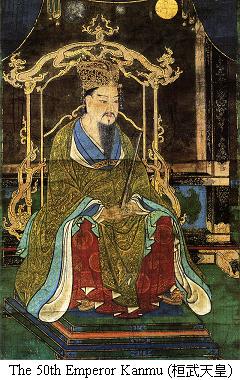 Emperor Kanmu (桓武天皇) was the first prince born between Shirakabeo(白壁王), who later became the 49th Emperor Konin (光仁天皇), and his Kyujin (宮人: the female staff who serves in the palace), Takanononiigasa (高野新笠) who had been from naturalized Baekje clan Yamato-uji(和氏) and later promoted to Fujin (夫人: the third rank wife). His mother's low status led him to start his career not as a royal family member but as a bureaucrat, and was promoted to Daigaku-to (大学頭: Head of university), Jiju (侍従: chamberlain) and lastly Shihon (四品: Fourth Order of an Imperial Prince) Nakatsukasa-kyo (中務卿: Minister of the Ministry of Central Affairs), but his appointment as crown prince (太子) was not expected. However, due to the political conflict involving Fujiwara clan (藤原氏) and others, his half brother Crown Prince Osabe Shinno (他戸親王) was abolished, and he was appointed as Crown Prince. It is said that there was a back up by Fujiwara Momokawa (藤原百川) of Fujiwara Shikke(藤原式家). After the coronation, Emperor Kanmu (桓武天皇) was empressed by Fujiwarano Otomuro(藤原乙牟漏), the daughter of Fujiwarano Yoshitsugu (藤原良継), the older brother of Momokawa (百川), and with her produced Prince Atenomiko(安殿親王) and Kaminomiko (神野親王). These sons later bicame Emperor Heijo (平城天皇) and Emperor Saga (嵯峨天皇) respectively. In addition, he also married Momokawa (百川)'s daughter and Yoshitsugu (良継)'s sotomago (外孫 grandchild from a daughter married into another family), Fujiwarano Tabiko (藤原旅子), and with her got another son, Otomonomiko (大伴親王). This son later became Emperor Junwa (淳和天皇). Therefore, it can be said that the foundation of Fujiwara clan's prosperity was built under Emperor Kanmu. After the coronation of Emperor Kanmu(桓武天皇), his mother, Niigasa (新笠), became Kotaifujin(皇太夫人: Late emperor's third rank wife), and his cousin, Yamatonoiemaro (和家麻呂), achieved an exceptional promotion. He also gave Niigasa (新笠) posthumous name "Amatakashirasuhinokohimenomikoto(天高知日之子姫尊: a princess who knows as daughter of sun in heaven)," because Yamatouji (和氏) was a descendant of Baekje's Muryonwan (武寧王) and Dong Myung Wan(都慕王), the ancestor of the Baekje dynasty, was born through marriage of the daughter of Kahaku(河伯: God of the Yellow River) and sunlight. ○Japan and Korea are next to each other: Emperor Heisei 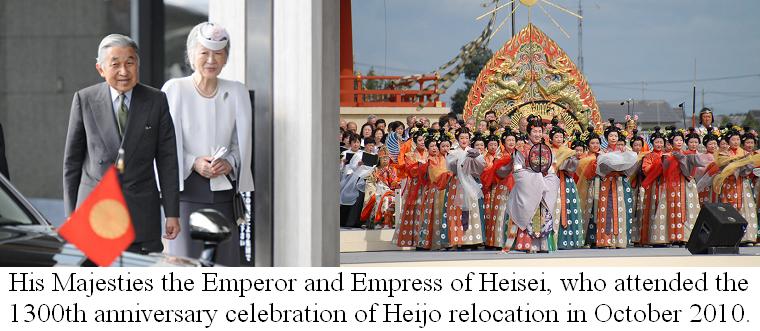 On 18 December 2001, during his annual birthday meeting with reporters, Emperor Heisei (平成天皇) regarding the Japan and Korea co-hosted the World Cup soccer tournament scheduled for the following year, said, "I, on my part, feel a certain kinship with Korea, given the fact that it is recorded in the Shoku Nihongi (続日本紀: the Chronicles of Japan) that Niigasa (新笠), the mother of Emperor Kammu (桓武天皇), was of the line of King Muryong (武寧王) of Baekje. King Muryong had a strong relationship with Japan, and since then, Gokyo Hakase (the expert of Five Classics of China) had been invited to Japan for generations. In addition, King Seimei (聖明王), the son of King Muryong, is known for introducing Buddhism to Japan." This statement received a great deal of attention in South Korea, and it was reported that "The Imperial Family of Japan draws Korean bloodline," "The theory of Japanese Imperial family's Baekje roots," "King of Japan revealed the hidden facts," and President Kim Dae Jung (金大中), too, welcomed at the 2002 New Year press conference. Emperor Heisei made a similar statement regarding the relationship with Baekje in the 1,300th anniversary of the establishment of Japan's old capital, Nara Heijo-kyo.<To be cntinued> 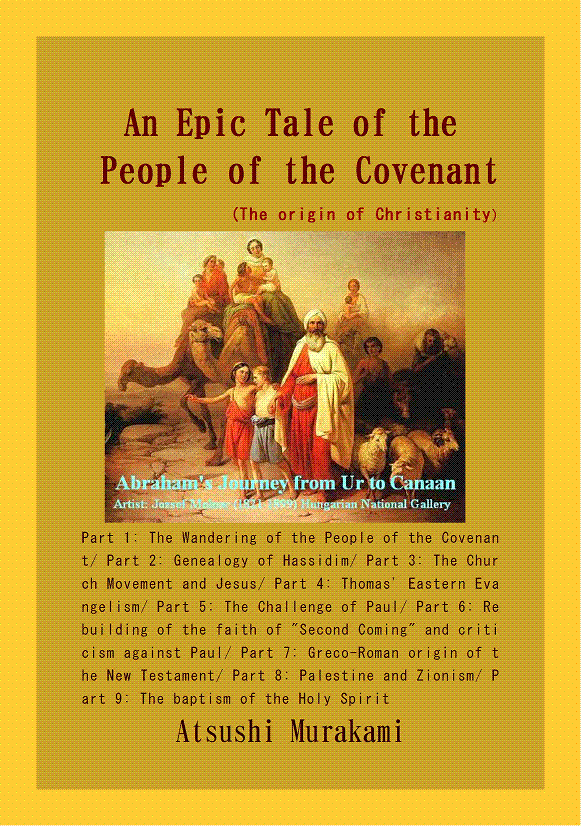 ○What is "Baptism with The Holy Spirit"? According to the dialectic of the Gospel of John, 【Thesis】"A man can possess eternal life through accepting testimony of the Son of man and being baptized by him." (John 5:24) 【Anti-thesis】But "The one who comes from the earth cannot accept the testimony by one from heaven." (John 3:32) How then can a man possess eternal life? 【Synthesis】"If you want to be baptized with the Holy Spirit, you can just go back to the word which was with God in the beginning (John 1:1) and certify that God is truthful. (John 3:33)" When he said, "You are Huichao," Zen Master Fayan thrusted vivid Self in Huichao in front of his eyes. Purchase here ○One world:The aim of SEAnews Your Comments / UnsubscribeTweet to @TwitterDev SEAnews MessengerSEAnewsFacebookSEAnews eBookstoreSEAnews world circulation |
|
[Your Comments / Unsubscribe]/[您的意见/退订]/[ご意見/配信停止]
Please do not directly reply to the e-mail address which is used for delivering the newsletter. 请别用递送新闻的邮件地址而直接回信。 メールをお届けした送信専用アドレスには返信しないで下さい。 |